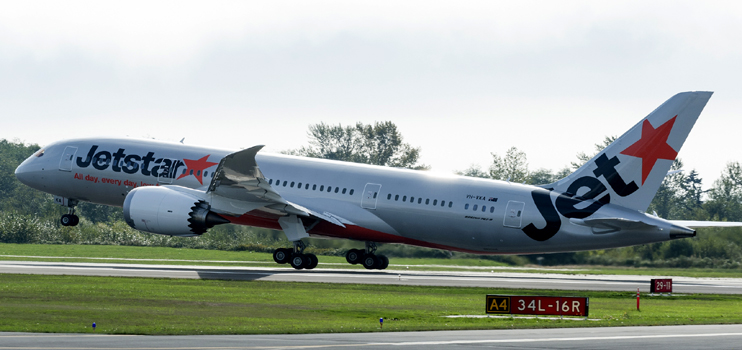Jetstar says it is working with safety investigators, engine manufacturer GE and Boeing to determine what caused fluctuations in both engines of a Boeing 787 Dreamliner as it approached the Japanese City of Osaka on March 29.
The airline said rumors the engines had flamed out were incorrect but pilots received an alert indicating a temporary variation in engine speed as the plane approached Kansai International Airport.
It said no emergency was declared and a priority landing was not requested.
“During this time both engines continued to operate and our pilots followed procedures, landing the flight normally,’’ a spokeswoman said.
READ Jetstar Asia showcases Australia’s red top end.
“Our engineers are assessing the aircraft in Japan, and we are working with the ATSB, CASA, GE and Boeing to investigate the cause of the fluctuations.”
Customers booked on the aircraft’s return flight were moved to alternative services.
The Australian Transport Safety Bureau confirmed it was aware of an “engine surging event” involving the Jetstar 787 and said it was liaising with colleagues at the Japan Transport Safety Board about an expected investigation.
An engine surge occurs when the airflow is disrupted as it passes through the turbine and can be the result of a number of factors. It can be transient and self-correcting or may need the pilots to intervene.
In severe cases, it can damage the engine.
There have been a series of engine failures and groundings involving 787s because of problems with Rolls-Royce Trent 1000 engines but Jetstar’s aircraft have the rival GEnx powerplants.
Double engine failures are rare but they do happen.
The ATSB is investigating a double flame-out on a Virgin Australia commuter plane last December.
Both engines on the Virgin ATR-72-600 turboprop, registration VH-FVN, experienced problems near Canberra Airport on December 13.
Although the ATR disruptions were momentary and the aircraft landed safely, the low probability of both engines shutting down during a flight means the ATSB is treating the incident as serious.
























